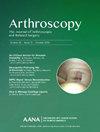在关节镜辅助下进行胸小肌转移术治疗肩袖前上方大面积撕裂并伴有无法修复的肩胛下肌撕裂,可在短期随访中显著改善疼痛和功能。
IF 5.4
1区 医学
Q1 ORTHOPEDICS
Arthroscopy-The Journal of Arthroscopic and Related Surgery
Pub Date : 2024-10-18
DOI:10.1016/j.arthro.2024.10.013
引用次数: 0
摘要
目的:本研究的目的是报告关节镜辅助下胸小肌转移的结果,并将适应症扩大到拉弗塞 4 型病例。此外,还探讨了胸小肌转移的预后因素,包括 Lafosse 分类:方法:回顾性分析了关节镜辅助下胸小肌肌腱转移术治疗肩袖前上方大面积撕裂伴不可修复的肩胛下撕裂的疗效,随访时间至少为 24 个月。所有患者在术前和术后均使用改良的加州大学洛杉矶分校(UCLA)评分、活动范围和视觉模拟疼痛量表(pain-VAS)进行评估。采用多元回归模型确定 UCLA 评分和升高的预测因素:连续评估了 74 名患者(平均 69.4 岁;65 名男性)。平均 UCLA 评分从术前的 15.3 分升至术后的 30.9 分(P < 0.001)。平均主动抬高角度从术前的 104°增加到术后的 148°(P < 0.001)。平均主动外旋角度从术前的47°增加到术后的57°(P < 0.001)。疼痛-VAS评分从术前的62毫米提高到术后的11毫米(P < 0.001)。手术未出现严重并发症,但有一名患者因持续疼痛而进行了肩关节翻转手术。在多元回归分析中,术前外旋角度(P = 0.0028)和抬高角度(P = 0.00067)分别是预测UCLA和抬高的积极因素。Lafosse分类不是一个重要因素:结论:在关节镜辅助下进行胸小肌转移可显著改善肩部的整体疼痛和功能。结论:关节镜辅助下胸小肌转移术可明显改善肩部疼痛和功能的总体状况,术前活动范围更佳是临床效果更佳的重要预测因素;拉弗塞分级对预后影响不大:证据级别:IV级,回顾性治疗病例系列。本文章由计算机程序翻译,如有差异,请以英文原文为准。
Arthroscopically Assisted Pectoralis Minor Transfer for Anterosuperior Massive Rotator Cuff Tear With Irreparable Subscapularis Tears Leads to Significant Improvement in Pain and Function at Short-Term Follow-Up
Purpose
To report the results of an arthroscopically assisted pectoralis minor transfer with an expanded indication to include Lafosse type 4 cases. In addition, prognostic factors for pectoralis minor transfer, including the Lafosse classification, were explored.
Methods
Outcomes of arthroscopically assisted pectoralis minor tendon transfer for anterosuperior massive rotator cuff tear with irreparable subscapularis tears with a minimum follow-up of 24 months were retrospectively reviewed. Severe pseudoparesis with flexion of less than 30° was not indicated. All patients were evaluated preoperatively and postoperatively using a modified University of California Los Angeles (UCLA) score, active range of motion, and the visual analog pain scale. Multiple regression models were used to determine predictors for UCLA score and elevation.
Results
Seventy-four consecutive patients (mean, 69.4 years; 65 men) were evaluated. The mean UCLA score increased from 15.3 preoperatively to 30.9 postoperatively (P < .001). The mean active elevation increased from 104° preoperatively to 148° postoperatively (P < .001). The mean active external rotation increased from 47° preoperatively to 57° postoperatively (P < .001). The visual analog pain scale improved from 62 to 11 mm postoperatively (P < .001). There were no serious complications, but 1 was revised with reverse shoulder due to ongoing pain. In multiple regression analysis, the positive predictors of UCLA and elevation were the preoperative external rotation angle (P = .0028) and elevation angle (P = .00067), respectively. Lafosse classification was not a significant factor.
Conclusions
Arthroscopically assisted pectoralis minor transfer led to significant improvement in overall shoulder pain and function. Better preoperative range of motion was a significant predictor of better clinical outcomes; Lafosse classification was not significant as a prognostic factor.
Level of Evidence
Level IV, retrospective therapeutic case series.
求助全文
通过发布文献求助,成功后即可免费获取论文全文。
去求助
来源期刊
CiteScore
9.30
自引率
17.00%
发文量
555
审稿时长
58 days
期刊介绍:
Nowhere is minimally invasive surgery explained better than in Arthroscopy, the leading peer-reviewed journal in the field. Every issue enables you to put into perspective the usefulness of the various emerging arthroscopic techniques. The advantages and disadvantages of these methods -- along with their applications in various situations -- are discussed in relation to their efficiency, efficacy and cost benefit. As a special incentive, paid subscribers also receive access to the journal expanded website.

 求助内容:
求助内容: 应助结果提醒方式:
应助结果提醒方式:


